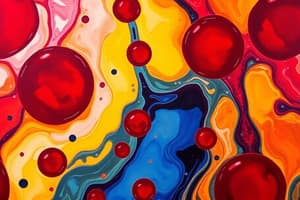Podcast
Questions and Answers
Red blood cells are produced in the red bone marrow of long ______.
Red blood cells are produced in the red bone marrow of long ______.
bones
The respiratory pigment that fills red blood cells is called ______.
The respiratory pigment that fills red blood cells is called ______.
haemoglobin
White blood cells defend the body from ______.
White blood cells defend the body from ______.
attack
Monocytes account for about ______% of all white blood cells.
Monocytes account for about ______% of all white blood cells.
Lymphocytes make up ______% of all white blood cells.
Lymphocytes make up ______% of all white blood cells.
T Cells ______ invaders.
T Cells ______ invaders.
B-Cells ______ antibodies.
B-Cells ______ antibodies.
Platelets are cellular fragments that play a major role in ______.
Platelets are cellular fragments that play a major role in ______.
Fibrin forms a network of strands across the wound, trapping blood cells and forming a ______.
Fibrin forms a network of strands across the wound, trapping blood cells and forming a ______.
Blood groupings are based on ______ that occur on the outer surface of blood cells.
Blood groupings are based on ______ that occur on the outer surface of blood cells.
An antigen is a substance that produces an immune ______.
An antigen is a substance that produces an immune ______.
If the mother is Rhesus negative, and the unborn child is Rhesus positive, some of the baby's red blood cells may cross into the mother's ______.
If the mother is Rhesus negative, and the unborn child is Rhesus positive, some of the baby's red blood cells may cross into the mother's ______.
Blood with the rhesus antigen on the surface is said to be Rhesus ______.
Blood with the rhesus antigen on the surface is said to be Rhesus ______.
People with Blood Group O have ______ antigens.
People with Blood Group O have ______ antigens.
A severe allergic reaction can occur if someone receives the wrong blood ______.
A severe allergic reaction can occur if someone receives the wrong blood ______.
Flashcards are hidden until you start studying
Study Notes
Blood Composition
- Plasma constitutes 55% of blood, composed of 90% water and 10% proteins, salts, nutrients, and waste.
Functions of Plasma Proteins
- Clotting proteins prevent blood loss and pathogen entry.
- Antibodies target pathogens and damaged cells for immune response.
- Albumen maintains osmotic balance in the body.
Functions of Dissolved Salts
- Essential for maintaining osmotic balance and cellular function.
Red Blood Cells (RBCs)
- Most abundant blood cells, produced in the red bone marrow.
- Mature RBCs lack a nucleus and mitochondria, enhancing oxygen transport efficiency.
- Biconcave shape filled with hemoglobin; lifespan of about 120 days.
- RBCs are recycled by the spleen and liver, forming bile pigments.
White Blood Cells (WBCs)
- Produced in bone marrow, their count increases during infections.
- Key defenders against pathogens with several types:
- Monocytes: Largest WBC, comprising 7% of white blood cells, engage in phagocytosis and antigen presentation.
- Lymphocytes: Make up 20-40% of WBCs, mostly short-lived; include T-cells (attack invaders) and B-cells (produce antibodies).
Platelets
- Cellular fragments essential for blood clotting.
- Aggregate at wound sites, triggering fibrin production, which forms a clot to prevent blood loss and pathogen entry.
Blood Groups
- Blood type is determined by antigens on the cell surface; crucial for safe blood transfusions.
- Incorrect blood type transfusion can trigger severe allergic reactions.
- Blood Group Distribution:
- O: 55% (neither A nor B antigens, A and B antibodies)
- A: 31% (A antigens, B antibodies)
- B: 11% (B antigens, A antibodies)
- AB: 3% (A and B antigens, no antibodies)
Rhesus Factor
- Identified in Rhesus monkeys; indicates the presence (RhD+) or absence (RhD-) of rhesus protein on blood cells.
Importance in Pregnancy
- If a Rh- mother carries a Rh+ baby, her body may produce antibodies against the baby's Rh antigens.
- This sensitization is usually not harmful in the first pregnancy but can be dangerous in subsequent Rh+ pregnancies.
- To prevent complications, Rh- mothers may receive Rh antibodies after their first child.
Mandatory Practical – Dissecting a Sheep's or Ox's Heart
- Position the heart for dissection, identifying major blood vessels: aorta, pulmonary artery, vena cava, pulmonary vein.
- Cut and examine the left and right ventricles and atria, locating bicuspid and tricuspid valves and their chordae tendinae.
- Observe structural differences between left and right ventricles.
- Identify the septum and the coronary arteries by pumping air through the aorta.
Mandatory Practical – Investigating Pulse Rate and Exercise
- Measure resting pulse at the wrist using two fingers; count beats in 15 seconds and multiply by four for beats per minute.
Studying That Suits You
Use AI to generate personalized quizzes and flashcards to suit your learning preferences.




